 Shaun Woodward (right) the MP famed for the twin disgraces of his defection from the Conservatives to Labour and a stint working with Esther Rantzen on That’s Life, is now Creative Industries minister and is busy singing the virtues of the UK’s Digital TV switchover plans.
Shaun Woodward (right) the MP famed for the twin disgraces of his defection from the Conservatives to Labour and a stint working with Esther Rantzen on That’s Life, is now Creative Industries minister and is busy singing the virtues of the UK’s Digital TV switchover plans.
According to the minister, there’s going to be a golden digital age in the UK as more and more employment is provided by the creative industries, our children enjoy interactive education, the sick benefit from Tele-medicine and the new technologies even help the government with transport and defence industries.
Woodward speaking last week at a Royal Television Society event, Digital Switchover- Making it Happen did not seem to think that finding the £26.99 that you can now buy a Freeview box from Argos for, would pose a problem amongst the financially challenged members of the electorate in the deprived St Helens constituency he now represents. Woodward in fact hinted obliquely that although they might fail to feed their children properly and many have high levels of debt, he’d observed some good ‘entertainment kit’ in their homes.
Accompanied by Ford Ennals (below right) the Chief executive of Digital UK, the body charged with making it happen, he made clear that BBC licence fee; although not yet agreed, would be settled by the end of the year and this was would fit in with the digital switchover schedule. ‘The Government needs to be satisfied that licence fee payers are getting value for money,’ he told the audience but he was ‘confident that they’ll get the right number’ at the end of the process of negotiation with the BBC.
Ennals revealed that surveys from trial areas indicated high levels of satisfaction particularly amongst the over 75s, who along with other vulnerable groups that might find the new technology challenging, would be getting assistance. Ennals is busy co-ordinating Digital UK’s nine project strands that include the thorny issue of resolving the platforms being made available to those in Multi Dwelling Units (that’s flats and the like to you and me).
The switchover which is being rolled out region by region, will swap out the old analogue transmissions with super new digital ones starting in what was the Border TV region in 2008 and finishing up, not as originally planned in London, but in the less challenging areas of Tyne Tees and Ulster thus avoiding any conflict with 2012 Olympic games coverage in the nation’s capital.
 Digital UK had the current 98.5% coverage as a target and expects to meet this with additional coverage being by satellite, cable and broadband. Current figures indicate a rump of around 2% of refuseniks, those viewers content with a meagre 4 or 5 channels who see no value in multi-channel viewing, but expectations are this number will shrink as the digitisation spreads across the country like a warm front.
Digital UK had the current 98.5% coverage as a target and expects to meet this with additional coverage being by satellite, cable and broadband. Current figures indicate a rump of around 2% of refuseniks, those viewers content with a meagre 4 or 5 channels who see no value in multi-channel viewing, but expectations are this number will shrink as the digitisation spreads across the country like a warm front.
The average cost per household is predicted to be around £130 the extra costs are likely to be those second and third TV sets that are so easily forgotten, new rooftop aerials and replacement of analogue video recorders.
Woodward repeatedly refused to answer the question as to why the government felt it was the BBC’s responsibility to handle switchover issues rather than Government, who have been happy to find funding to subsidise the over 75s TV licence fees.
The Minister agreed that there were questions still to be resolved, like the value of continuing the current ‘gifting’ of spectrum to Public Service Broadcasters after switchover, and how the desire for High Definition would be met, but they were being evaluated so no need to worry there then.
Digital UK with stakeholders across industry and broadcasting would not make the mistakes seen in Italy, where a planned ‘big bang’ switchover for 2006 had not even registered as a moderate whimper. In the UK it is all so far going swimmingly and Ford thinks the BBC will be keeping up the good work as long as the BBC licence fee is agreed by year end as Shaun assured us it will.
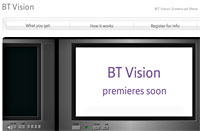 As we’ve covered extensively, BT has been working on BT Vision for yonks now, perhaps struggling with some of the technical issues with the Microsoft system that they’re running.
As we’ve covered extensively, BT has been working on BT Vision for yonks now, perhaps struggling with some of the technical issues with the Microsoft system that they’re running. 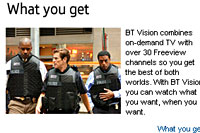 Viewers will be able to pause and rewind live TV and enjoy access to around 30 Freeview channels.
Viewers will be able to pause and rewind live TV and enjoy access to around 30 Freeview channels.  BT is set to start rolling out the service early next year, although it’s going to be a bit of a half-cocked launch with only Channel Four currently signed up for the seven-day “catch-up” service (behind the scenes, BT’s legal team are busy battling with BBC and ITV producers to negotiate a path through the minefield of rights.)
BT is set to start rolling out the service early next year, although it’s going to be a bit of a half-cocked launch with only Channel Four currently signed up for the seven-day “catch-up” service (behind the scenes, BT’s legal team are busy battling with BBC and ITV producers to negotiate a path through the minefield of rights.)  Video sharing Websites like YouTube are starting to impact on TV viewing figures, with more people switching off and logging on.
Video sharing Websites like YouTube are starting to impact on TV viewing figures, with more people switching off and logging on. 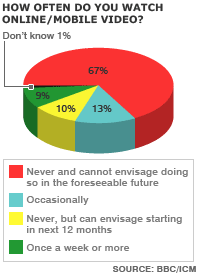 A further 13% of those questioned said they watched online occasionally, with another 10 per cent saying they expected to start in the coming year.
A further 13% of those questioned said they watched online occasionally, with another 10 per cent saying they expected to start in the coming year.  The majority of the population still prefers to watch the old fashioned gogglebox, with two-thirds of the population shunning online TV and saying that had no intention of starting in the next 12 months.
The majority of the population still prefers to watch the old fashioned gogglebox, with two-thirds of the population shunning online TV and saying that had no intention of starting in the next 12 months. 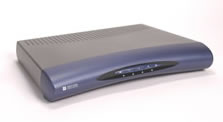 Over the last ten years, Motorola has moved from the first commercial digital STB to shipping fifty million digital STBs.
Over the last ten years, Motorola has moved from the first commercial digital STB to shipping fifty million digital STBs. 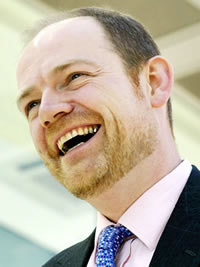 BBC Director-General Mark Thompson is back on again trying to justify to the British government why the BBC should be allowed to increase their licence fee above the Retail Price Index (
BBC Director-General Mark Thompson is back on again trying to justify to the British government why the BBC should be allowed to increase their licence fee above the Retail Price Index (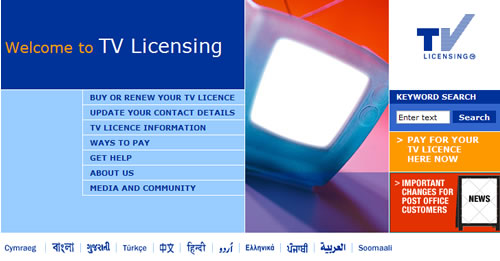
 Last week was the annual get together of TV ‘luvvies’ in Edinburgh and this year, as for the last few years, the current moguls felt it necessary to behave like Scrooge, reflect on their previous misdemeanours and take a bit of a look at TV to come.
Last week was the annual get together of TV ‘luvvies’ in Edinburgh and this year, as for the last few years, the current moguls felt it necessary to behave like Scrooge, reflect on their previous misdemeanours and take a bit of a look at TV to come.  The spectre of Banquo’s ghost in the shape of everyone’s (now) favourite caterer, Mr Charles Allen, was there and delivered the keynote address, he of course blamed all and sundry for the mess ITV is in – ‘nothing to do with me guv’ should have been the title.
The spectre of Banquo’s ghost in the shape of everyone’s (now) favourite caterer, Mr Charles Allen, was there and delivered the keynote address, he of course blamed all and sundry for the mess ITV is in – ‘nothing to do with me guv’ should have been the title.  Today it was announced that Whitehaven, Cumbria will be the first area in England to have its TV reception changed over from analog to digital.
Today it was announced that Whitehaven, Cumbria will be the first area in England to have its TV reception changed over from analog to digital.  Shaun Woodward (right) the MP famed for the twin disgraces of his defection from the Conservatives to Labour and a stint working with Esther Rantzen on That’s Life, is now Creative Industries minister and is busy singing the virtues of the UK’s Digital TV switchover plans.
Shaun Woodward (right) the MP famed for the twin disgraces of his defection from the Conservatives to Labour and a stint working with Esther Rantzen on That’s Life, is now Creative Industries minister and is busy singing the virtues of the UK’s Digital TV switchover plans.  Digital UK had the current 98.5% coverage as a target and expects to meet this with additional coverage being by satellite, cable and broadband. Current figures indicate a rump of around 2% of refuseniks, those viewers content with a meagre 4 or 5 channels who see no value in multi-channel viewing, but expectations are this number will shrink as the digitisation spreads across the country like a warm front.
Digital UK had the current 98.5% coverage as a target and expects to meet this with additional coverage being by satellite, cable and broadband. Current figures indicate a rump of around 2% of refuseniks, those viewers content with a meagre 4 or 5 channels who see no value in multi-channel viewing, but expectations are this number will shrink as the digitisation spreads across the country like a warm front.  Channel 4 has today launched a new broadband Simulcast service, making their live TV schedule available online for viewing, for free.
Channel 4 has today launched a new broadband Simulcast service, making their live TV schedule available online for viewing, for free.  Channel 4 has, however, said that it is negotiating with US studios to add their content at a later date.
Channel 4 has, however, said that it is negotiating with US studios to add their content at a later date. 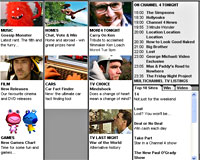 Appearing in a thundercloud of enthusiasm, Channel 4 CEO Andy Duncan was on-beam and on-message and rapidly hit evangelical overdrive, describing the Web transmission as an opportunity “to build on what Channel 4 has always done – stimulate, infuriate, debate, create,” adding that he didn’t see the digital revolution as an attack on Channel 4’s power as a public broadcaster, but as a “fantastic opportunity,”
Appearing in a thundercloud of enthusiasm, Channel 4 CEO Andy Duncan was on-beam and on-message and rapidly hit evangelical overdrive, describing the Web transmission as an opportunity “to build on what Channel 4 has always done – stimulate, infuriate, debate, create,” adding that he didn’t see the digital revolution as an attack on Channel 4’s power as a public broadcaster, but as a “fantastic opportunity,” 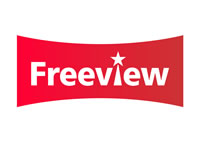 We wouldn’t normally bore you with tales of how many more percent of the UK population have joined the Digital TV-owning army, but this one is a significant one.
We wouldn’t normally bore you with tales of how many more percent of the UK population have joined the Digital TV-owning army, but this one is a significant one. 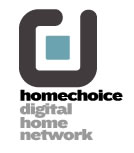 TV over ADSL First
TV over ADSL First Additional TV Sets – Ongoing problems
Additional TV Sets – Ongoing problems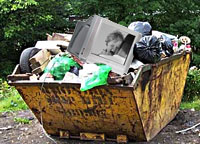 In a few years time, kids will be clutching their sides and laughing at the thought that their parents used to watch TV on massive great boxes that filled up half the living room.
In a few years time, kids will be clutching their sides and laughing at the thought that their parents used to watch TV on massive great boxes that filled up half the living room.  Style over picture
Style over picture